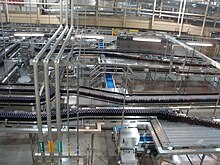Bottling line

Bottling lines are production lines that fill a product, generally a beverage, into bottles on a large scale.[1] Many prepared foods are also bottled, such as sauces, syrups, marinades, oils and vinegars.[2][3][4][5]
Beer bottling process

Packaging of bottled beer typically involves drawing the product from a holding tank and filling it into bottles in a filling machine (filler), which are then capped, labeled and packed into cases or cartons. Many smaller
The first step in bottling beer is depalletising, where the empty bottles are removed from the original
Next the bottle enters a labelling machine ("labeller") where a label is applied. To ensure traceability of the product, a lot number, generally the date and time of bottling, may also be printed on the bottle. The product is then packed into boxes and warehoused, ready for sale.[6]
Depending on the magnitude of the bottling endeavor, there are many different types of bottling machinery available. Liquid level machines fill bottles so they appear to be filled to the same line on every bottle, while volumetric filling machines fill each bottle with exactly the same amount of liquid. Overflow pressure fillers are the most popular machines with beverage makers, while gravity filling machines are most cost effective. In terms of automation, inline filling machines are most popular, but rotary machines are much faster albeit much more expensive.[7]
Wine bottling process
The process for bottling
Some bottling lines incorporate a fill height detector which reject under or over-filled bottles, and also a metal detector.
After filling and corking, a plastic or tin capsule is applied to the neck of the bottle in a capsular. Next the bottle enters a labeller where a wine label is applied. The product is then packed into boxes and warehoused, ready for sale.
See also
- Beverage can
- Packaging and labeling
References
- ISBN 978-1-4615-2810-4. Retrieved November 2, 2017.
- ISBN 978-0-07-134736-5. Retrieved November 2, 2017.
- ISBN 978-0-7432-1403-2. Retrieved November 2, 2017.
- ^ Western Canner and Packer. Miller Freeman Publications of California. 1953. p. 283. Retrieved November 2, 2017.
- ^ Glass Packer. Ogden-Watney publishers. 1951. p. 717. Retrieved November 2, 2017.
- ISBN 0-471-06397-5
- ^ "How to Buy A Bottling Line". Kinnek.com. Retrieved 2013-06-25.
Further reading
- Yam, K. L., "Encyclopedia of Packaging Technology", John Wiley & Sons, 2009, ISBN 978-0-470-08704-6
External links
 Media related to Bottling plants at Wikimedia Commons
Media related to Bottling plants at Wikimedia Commons- Liquid Filling Lines
